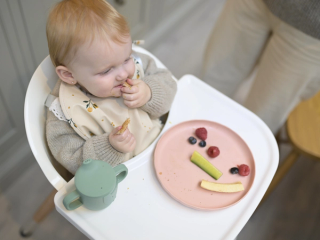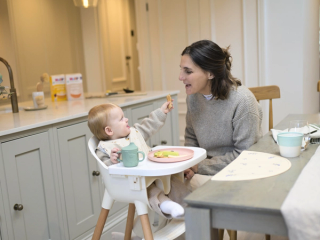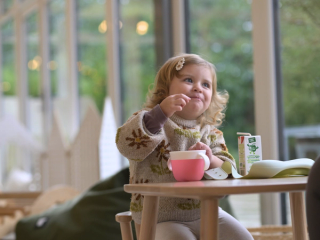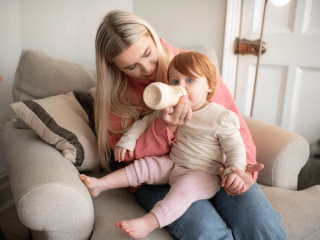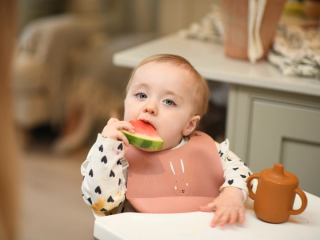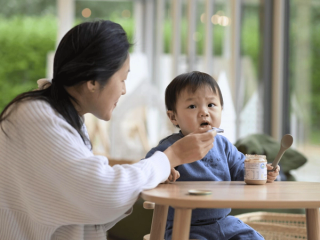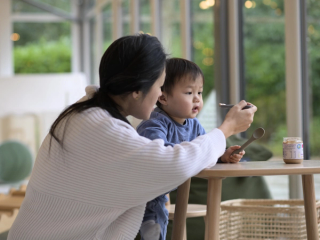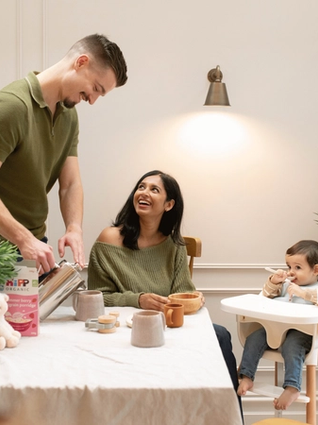
- Home
- Advice Hub
- Toddler
- Toddler Feeding
- Moving Your Toddler Onto Family Meals
Moving your toddler onto family meals
Once your little one reaches toddler hood, mealtimes get a bit more interesting. Getting to eat as a family – and being able to eat the same thing – can be a very rewarding, joyful experience.
If your baby has gone from happily sitting in the highchair, eating everything you put in front of them to a food-refusing, plate-throwing, strong-willed toddler – don’t worry. Frustrating as it is, this is a normal stage of development. And like so many things in parenting, it’s all about adjusting as you navigate through each stage.
Once your little one reaches toddlerhood, mealtimes get a bit more interesting. In amongst the often unpredictable behaviour (cleaned a spag bol off the floor recently, anyone?) there is also the opportunity to try new things. Getting to eat as a family – and being able to eat the same thing – can be a very rewarding, joyful experience.
What to expect?
By your baby’s first birthday they should be eating chopped foods alongside a variety of other textures. Essentially, their meal should look similar to the rest of the family’s and there should be plenty of opportunities across the week to be exploring different foods as they are still doing a lot of learning.
Portion sizes
You should carry on (or if you’re not yet doing it – start to) feed your baby responsively. This means letting them eat to their appetite and not encouraging them to eat more when they are full.
This is especially important as your child moves into toddlerhood. At around a year your little one’s growth slows, and their appetite will drop as they don’t need as much food anymore. If you’re still trying to get them to eat what they did previously, you may end up with a battle on your hands!
Look out for fullness cues such as clamping their mouth shut, turning away from the spoon, stopping eating if self-feeding, throwing food on the floor and getting upset in the highchair. Try to avoid the temptation to ask them to take ‘one more mouthful’ and instead finish the meal and start the clean-up mission.
Choking risk
Your toddler won’t develop their adult chewing skills until they are around 3 years of age, so whilst it’s great to encourage them to eat the same foods as the rest of the family you should still be conscious of choking risks.
Some of the foods you need to consider include:
- Popcorn
- Whole nuts (avoid these until your little one is 5 years old).
- Cylindrical foods – like frankfurters or baby carrots. You should continue to cut these lengthways as well as across (so they are half or quarter circles instead of full circles)
- Hard round foods – things like grapes, olives, cherry tomatoes etc – should be cut in half lengthways.
If you haven’t refreshed your knowledge for a while, it’s a good time to have a look online at what to do if your child chokes. Though the risk is small, it’s always worth knowing how to respond.
Can toddlers really eat the same foods as grown-ups?
The quick answer is YES!
There are a few things you need to think about in order to make meals child-friendly and to create a healthy relationship between your toddler and their food:
Ensure you keep the salt content low
Below 2g a day. Many standard foods like cheese, bread, processed meats etc. contain salt. Therefore it is recommended that you avoid adding salt when you are cooking and be aware of high salt foods like ready-made sauces, stock cubes, gravies and powdered flavourings. When choosing convenience foods, the baby food aisle is a great place to start. Regulations ensure that salt levels are appropriate for babies and toddlers. HiPP's toddler tray meals are a great option as there is no added salt (as required by law) but they still have loads of flavour and texture for happy mouths, happy tummies AND happy parents!
Use plenty of flavour
It’s a misconception that foods need to be bland and boring for young children or that salt is the only way to create flavour. Toddler meals can have lots of flavour, so get adventurous with the herbs and spices you have in your cupboards. If you make something that has a little too much heat for your little one, you can add some plain yoghurt to reduce spice for them.
Keep sugar low
There’s a fine balance between teaching your little one moderation with sweet foods and promoting a sweet tooth. Little tastes here and there and some sweet foods alongside their meals and snacks is a good idea and often difficult to avoid completely (making them forbidden will only make them more exciting over time), but try to avoid giving larger portions of foods like chocolate, ice-cream, cakes etc until your little one is a bit older.
Don’t be a creature of habit
So many of us cook the same meals on rotation, which can restrict the number of meals your toddler will accept; especially if typical toddler fussy eating sets in before they turn 18 months. Don’t worry, you don’t have to be a chef or make a different meal everyday for a month. By simply changing up how you cook and present foods and by using different varieties of staples like bread, rice & pasta you will help your toddler to enjoy a range of different foods without too much time in the kitchen. Why not try fusilli pasta versus penne, or lentil pasta instead of standard? A basmati or wild rice instead of long grain, and seeded, granary or sourdough bread for a change every now and then. The swaps don't need to be expensive, just different.
Get them involved!
There are some great toddler utensils on the market which can make cooking with toddlers safe and more fun. Allowing them to explore foods helps them to be interested in eating and over time will make your life easier. It doesn’t have to be complicated – washing a vegetable in the sink, peeling a carrot, cutting some cucumber are all jobs a toddler can help you with. If you’re not ready for that, simply putting the highchair close whilst you cook can help them to feel involved.
Eat together as often as you can
Research shows that children that participate in family mealtimes are more likely to eat fruit and vegetables, may do better academically, and the whole family may have reduced rates of depression and better family bonds. We think those are some pretty good reasons to sit together for 20 minutes a day and to leave the washing up or other kitchen jobs for another time!
Your toddler will continue to learn by watching you, so sitting opposite and eating is a great way to teach new skills.
Have a good routine
Aiming for 3 meals a day and a mid-morning/mid-afternoon snack will help your little one to listen to their body, not get too hungry, but also give time for the appetite to build. Remember: nothing bad is going to happen if your toddler gets a little hungry; it’s good for them to know what hunger feels like! If you feed them every time there’s a slight desire for food you’ll forever be giving snacks and meals may not be eaten well, so try and find a good routine that provides balance between meal times and snacks in an average day.
Most of all, keep it simple and enjoy the time with your toddler (easier said than done on some days, we know!) Find new ways to enjoy food together, make it fun and inclusive and try to ignore the mess…
Advice & tips

Want to read more? Join the HiPP BabyClub for full access to this article.
As a BabyClub member, you'll get access to a range of exclusive benefits, including:
Monthly competitions
Discounts from our Partners
Expert advice tailored to your little one's age
Weaning recipes
HiPP shop discounts*
*10% off HiPP's online shop does not apply to our First Infant, Anti-Reflux or Comfort Formula Milk.
Important notice: Breastfeeding is best. Follow on milk should only be used as part of a mixed diet from 6 months. Talk to a healthcare professional.




